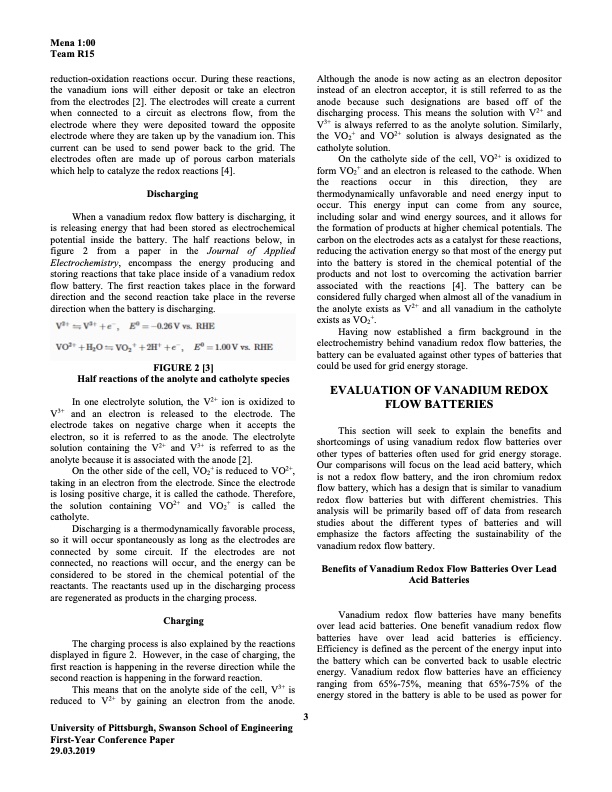
PDF Publication Title:
Text from PDF Page: 003
Mena 1:00 Team R15 reduction-oxidation reactions occur. During these reactions, the vanadium ions will either deposit or take an electron from the electrodes [2]. The electrodes will create a current when connected to a circuit as electrons flow, from the electrode where they were deposited toward the opposite electrode where they are taken up by the vanadium ion. This current can be used to send power back to the grid. The electrodes often are made up of porous carbon materials which help to catalyze the redox reactions [4]. Discharging When a vanadium redox flow battery is discharging, it is releasing energy that had been stored as electrochemical potential inside the battery. The half reactions below, in figure 2 from a paper in the Journal of Applied Electrochemistry, encompass the energy producing and storing reactions that take place inside of a vanadium redox flow battery. The first reaction takes place in the forward direction and the second reaction take place in the reverse direction when the battery is discharging. FIGURE 2 [3] Half reactions of the anolyte and catholyte species In one electrolyte solution, the V2+ ion is oxidized to V3+ and an electron is released to the electrode. The electrode takes on negative charge when it accepts the electron, so it is referred to as the anode. The electrolyte solution containing the V2+ and V3+ is referred to as the anolyte because it is associated with the anode [2]. On the other side of the cell, VO2+ is reduced to VO2+, taking in an electron from the electrode. Since the electrode is losing positive charge, it is called the cathode. Therefore, the solution containing VO2+ and VO2+ is called the catholyte. Discharging is a thermodynamically favorable process, so it will occur spontaneously as long as the electrodes are connected by some circuit. If the electrodes are not connected, no reactions will occur, and the energy can be considered to be stored in the chemical potential of the reactants. The reactants used up in the discharging process are regenerated as products in the charging process. Charging The charging process is also explained by the reactions displayed in figure 2. However, in the case of charging, the first reaction is happening in the reverse direction while the second reaction is happening in the forward reaction. This means that on the anolyte side of the cell, V3+ is reduced to V2+ by gaining an electron from the anode. 3 University of Pittsburgh, Swanson School of Engineering First-Year Conference Paper 29.03.2019 Although the anode is now acting as an electron depositor instead of an electron acceptor, it is still referred to as the anode because such designations are based off of the discharging process. This means the solution with V2+ and V3+ is always referred to as the anolyte solution. Similarly, the VO2+ and VO2+ solution is always designated as the catholyte solution. On the catholyte side of the cell, VO2+ is oxidized to form VO2+ and an electron is released to the cathode. When the reactions occur in this direction, they are thermodynamically unfavorable and need energy input to occur. This energy input can come from any source, including solar and wind energy sources, and it allows for the formation of products at higher chemical potentials. The carbon on the electrodes acts as a catalyst for these reactions, reducing the activation energy so that most of the energy put into the battery is stored in the chemical potential of the products and not lost to overcoming the activation barrier associated with the reactions [4]. The battery can be considered fully charged when almost all of the vanadium in the anolyte exists as V2+ and all vanadium in the catholyte exists as VO2+. Having now established a firm background in the electrochemistry behind vanadium redox flow batteries, the battery can be evaluated against other types of batteries that could be used for grid energy storage. EVALUATION OF VANADIUM REDOX FLOW BATTERIES This section will seek to explain the benefits and shortcomings of using vanadium redox flow batteries over other types of batteries often used for grid energy storage. Our comparisons will focus on the lead acid battery, which is not a redox flow battery, and the iron chromium redox flow battery, which has a design that is similar to vanadium redox flow batteries but with different chemistries. This analysis will be primarily based off of data from research studies about the different types of batteries and will emphasize the factors affecting the sustainability of the vanadium redox flow battery. Benefits of Vanadium Redox Flow Batteries Over Lead Acid Batteries Vanadium redox flow batteries have many benefits over lead acid batteries. One benefit vanadium redox flow batteries have over lead acid batteries is efficiency. Efficiency is defined as the percent of the energy input into the battery which can be converted back to usable electric energy. Vanadium redox flow batteries have an efficiency ranging from 65%-75%, meaning that 65%-75% of the energy stored in the battery is able to be used as power forPDF Image | VANADIUM REDOX FLOW BATTERIES FOR GREEN ENERGY

PDF Search Title:
VANADIUM REDOX FLOW BATTERIES FOR GREEN ENERGYOriginal File Name Searched:
c11-vanadium-redox-flow-batteries.pdfDIY PDF Search: Google It | Yahoo | Bing
Salgenx Redox Flow Battery Technology: Salt water flow battery technology with low cost and great energy density that can be used for power storage and thermal storage. Let us de-risk your production using our license. Our aqueous flow battery is less cost than Tesla Megapack and available faster. Redox flow battery. No membrane needed like with Vanadium, or Bromine. Salgenx flow battery
| CONTACT TEL: 608-238-6001 Email: greg@salgenx.com | RSS | AMP |